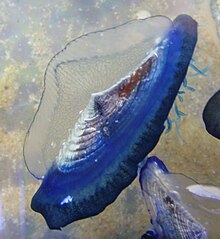| Velella | |
|---|---|

| |
| Close-up of a Velella velella colony | |
| Scientific classification | |
| Domain: | Eukaryota |
| Kingdom: | Animalia |
| Phylum: | Cnidaria |
| Class: | Hydrozoa |
| Order: | Anthoathecata |
| Family: | Porpitidae |
| Genus: | Velella Lamarck, 1801[1] |
| Species: | V. velella
|
| Binomial name | |
| Velella velella | |
| Synonyms | |
|
List (Genus)
(Species)
| |
Velella is a monospecific genus of hydrozoa in the Porpitidae family. Its only known species is Velella velella,[2] a cosmopolitan (widely distributed) free-floating hydrozoan that lives on the surface of the open ocean. It is commonly known by the names sea raft, by-the-wind sailor, purple sail, little sail, or simply Velella.[3]
This small cnidarian is part of a specialised ocean surface community that includes the better-known cnidarian siphonophore, the Portuguese man o' war. Specialized predatory gastropod molluscs prey on these cnidarians. Such predators include nudibranchs (sea slugs) in the genus Glaucus[4] and purple snails in the genus Janthina.[5]
Each apparent individual is a hydroid colony, and most are less than about 7 cm long. They are usually deep blue in colour, but their most obvious feature is a small stiff sail that catches the wind and propels them over the surface of the sea. Under certain wind conditions, they may be stranded by the thousand on beaches.[6]
Like other Cnidaria, Velella velella are carnivorous. They catch their prey, generally plankton, by means of tentacles that hang down in the water and bear cnidocysts (also called nematocysts). The toxins in their nematocysts are effective against their prey. While cnidarians all possess nematocysts, in some species the nematocysts and toxins therein are more powerful than other species. V. velella's nematocysts are relatively benign to humans, although each person may respond differently to contact with the nematocyst toxin. It is wise to avoid touching one's face or eyes after handling V. velella, and itching may develop on parts of the skin that have been exposed to V. velella nematocysts.


- ^ Lamarck, J. B. (1801). Système des animaux sans vertèbres. Paris, France: by the author and Deterville. p. 555 – via Biodiversity Heritage Library.
- ^ Schuchert P, ed. (2013). "Velella velella (Linnaeus, 1758)". World Hydrozoa database. World Register of Marine Species. Retrieved 23 April 2013.
- ^ Harrington Wells (1937). Seashore Life. Wagner Publishing Company, USA (see pages 138 and 144 in the 1942 edition)
- ^ Gosliner, T.M. (1987). Nudibranchs of Southern Africa page 127, ISBN 0-930118-13-8
- ^ Branch, G.M., Branch, M.L, Griffiths, C.L. and Beckley, L.E. (2010). Two Oceans: a guide to the marine life of southern Africa. Cape Town:Struik Nature. page 188. ISBN 9781770077720.
- ^ "By-the-wind-sailors: Creatures wash up on Guernsey beaches". BBC News. 2024-04-22. Retrieved 2024-04-23.